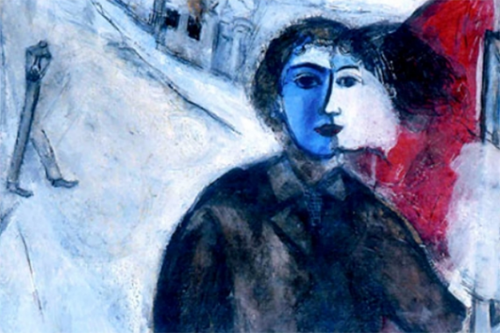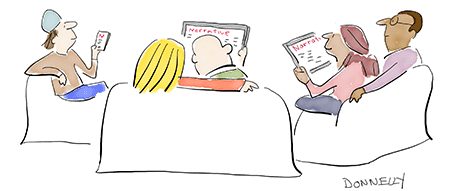The First Meeting
A Memoir
by Marc and Bella ChagallMany of Marc Chagall’s finest paintings feature Bella, his wife and muse, whom he continued to paint long after her death of an unknown illness at forty-nine. The couple first met by coincidence in Vitebsk, Belarus, their hometown, in the summer of 1909, when he was twenty-two and she was fourteen. The shock of a love at first sight, which grew to inspire great works, is famously recorded in Marc’s memoir My Life and in Bella’s published notebooks First Encounter. The excerpts here include each lover’s perspective on their meeting as well as an afterword written by Marc shortly after Bella’s death.

“Between darkness and night,” 1938–1943 (Oil on paper mounted on canvas, 39 3/8 x 28 3/4 in.) © 2015 Artists Rights Society (ARS), New York / ADAGP, Paris.
I.
The same sofa, undoubtedly, on which the doctor examined pregnant women and sick people suffering from stomach, head or heart trouble.
I lay down on that sofa, arms above my head and, dreaming, looked at the ceiling, the door, the place where Thea usually sat.
I’m waiting for her. She’s busy. She’s preparing dinner—fish, bread and butter—and her dog, big and heavy, keeps turning around her legs.
I lay down there on purpose so that Thea would come over to me, so she would kiss me. I held out my arms, the arms of salvation.
The bell rings. Who is that?
If it’s her father, I’ll have to get up from the sofa and go away.
Who is it then?
It’s a friend of Thea’s. She enters and I hear her voice, babbling away to Thea.
I stay in the consulting room. I don’t leave. Yes, I did go out, but the friend, whose back was towards me, didn’t see me.
I feel . . . what do I feel?
On the one hand, I’m annoyed at having my rest interfered with, my hope that Thea would perhaps come and sit beside me.
On the other, that young girl’s visit and her voice, like that of a bird from some other world, trouble me.
Who is she? I’m afraid. No, I want to speak to her, to be near her.
But she’s already saying good-bye to Thea. She scarcely glances at me and goes away.
Thea and I go out for a walk. On the bridge we meet her again. She is alone, all alone.
Suddenly I feel that I shouldn’t be with Thea, I should be with her.
Her silence is mine. Her eyes, mine. I feel she has known me always, my childhood, my present life, my future; as if she were watching over me, divining my innermost being, though this is the first time I have seen her.
I knew this is she, my wife.
Her pale coloring, her eyes. How big and round and black they are! They are my eyes, my soul.
I knew that Thea was nothing to me, a stranger.
I have entered a new house and I cannot be parted from it.

